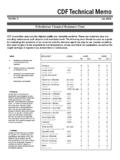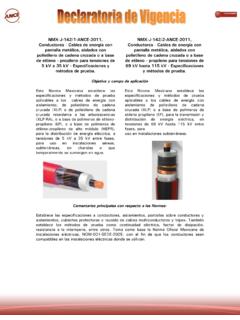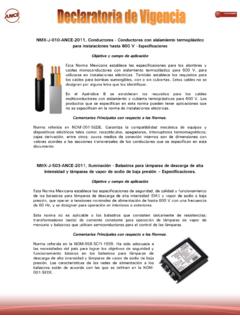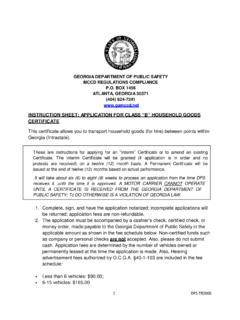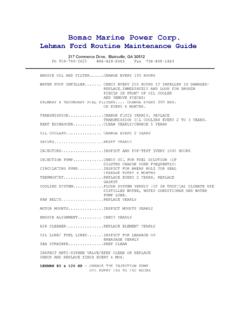Transcription of CDF Technical Memo
1 AcetoneB CB CAcetaldehyde*100%BCBCA cetic Acid*10%AAAAA cetic Acid*60%ABABA cetic Anhydride*CCCCAirAAAAA luminum Chlorideall concAAAAA luminum Fluorideall concAAAAA luminum Sulphateall concAAAAA lumsall typesAAAAA mmonia100% dry gas AAAAA mmonium CarbonateAAAAA mmonium Chloridesat dAAAAA mmonium Fluoridesat dAAAAA mmonium Hydroxide10%AAAAA mmonium Hydroxide28%AAAAA mmonium Nitratesat dAAAAA mmonium Persulphatesat dAAAAA mmonium Sulphatesat dAAAAA mmonium Metaphosphate sat dAAAAA mmonium Sulfidesat dAAAAAmyl Acetate#*100%CCCCAmyl Alcohol#*100%AAAAAmyl Chloride#100%CCCCA niline#*100%ACCBAqua Regia+CCCCA rsenic Acidall concAAAAA romatic Hydrocarbons#*CCCCA scorbic Acid10%AAAAB arium Carbonatesat dAAAAB arium Chloridesat dAAAAB arium HydroxideAAAAB arium Sulphatesat dAAAAB arium Sulphidesat dAAAABeerAAAAB enzene#*CCCCPP oollyyeetthhyylleennee CChheemmiiccaall RReessiissttaannccee CChhaarrttCDF Corporation uses only the highest quality raw materials available.
2 These raw materials have out-standing resistance to both physical and chemical attack. The following chart should be used as a guidefor evaluating the suitability of our products with the chemical agent you plan to use. Special considera-tion must be given to the expected service temperature, stress involved in the application, as well as thelength and type of exposure ( intermittent or continuous).CDF Technical MemoNumber 1 July 2004# Plasticizer. Certain types of chemicals areabsorbed to varying degrees by poly-ethylene causing swelling, weight-gain,softening and some loss of yieldstrength.
3 These plasticizing materialscause no actual chemical degrada-tion of the resin. Several of thesechemicals have a strong plasticizingeffect ( aromatic hydrocarbonsbenzene), whereas others have weakereffects ( gasoline). Certain plasti-cizers are sufficiently volatile that ifthey are removed from contact withthe polyethylene, the part will dry outand return to its original condition withno loss of properties.+ are the only group of materi-als capable of chemically degradingpolyethylene. The effects on the poly-ethylene may be gradual even forstrong oxidizers and short-term effectsmay not be measurable.
4 However, ifcontinuous long-term exposure isintended, the chemical effects shouldbe checked AResistant no indication thatserviceability would resistance, dependingon conditions of , not recommendedfor service applications underany not 140 70 140 Benzoic Acidall concAAAAB ismuth Carbonatesat dAAAAB leach Lye10%AAAAB oraxsat dAAAAB oric Acidall concAAAAB oron TrifluorideAAAAB rineAAAAB romine+liquidCCCCB romine Water#sat dCCCCB utanediol*10%AAAAB utanediol*60%AAAAB utanediol*100%AAAAB utter*AAAAn-Butyl Acetate#*100%BCABn-Butyl Alcohol*100%AAAAB utyric Acid#concCCCCC alcium BisulphideAAAAC alcium Carbonatesat dAAAAC alcium Chloratesat dAAAAC alcium Chloridesat dAAAAC alcium HydroxideconcAAAAC alcium
5 Hypochloridebleach solAAAAC alcium Nitrate50%AAAAC alcium Oxidesat dAAAAC alcium SulphateAAAAC amphor Oil#*CCBCC arbon Dioxideall concAAAAC arbon DisulphideCCCCC arbon MonoxideAAAAC arbon Tetrachloride#CCBCC arbonic AcidAAAAC astor 0il*concAAAAC hlorine+100% dry gas BCCCC hlorine Liquid+CCCCC hlorine Water+2% sat d solAAAAC hlorobenzene#*CCCCC hloroform*#CCBCC hlorosulphonic Acid 100%CCCCC hrome Alumsat dAAAAC hromic Acid80%----Chromic Acid50%ABABC hromic Acid10%AAAAC ider*AAAAC itric Acid*sat dAAAAC oconut 0il Alcohols*AAAAC offeeAAAACola Concentrate*AAAAC opper Chloridesat dAAAAC opper Cyanidesat dAAAAC opper Fluoride2%AAAAC opper Nitratesat dAAAAC opper Sulphatesat dAAAACorn 0il*AAAAC ottonseed 0il*AAAAC uprous Chloridesat dAAAAD etergents Synthetic*AAAAD evelopers PhotographicAAAAD extrinsat dAAAAD extrosesat dAAAACODES AResistant no indication thatserviceability would resistance, dependingon conditions of , not recommendedfor service applications underany not available.
6 # Plasticizer. Certain types of chemicals areabsorbed to varying degrees by poly-ethylene causing swelling, weight-gain,softening and some loss of yieldstrength. These plasticizing materialscause no actual chemical degrada-tion of the resin. Several of thesechemicals have a strong plasticizingeffect ( aromatic hydrocarbonsbenzene), whereas others have weakereffects ( gasoline). Certain plasti-cizers are sufficiently volatile that ifthey are removed from contact withthe polyethylene, the part will dry outand return to its original condition withno loss of properties.
7 + are the only group of materi-als capable of chemically degradingpolyethylene. The effects on the poly-ethylene may be gradual even forstrong oxidizers and short-term effectsmay not be measurable. However, ifcontinuous long-term exposure isintended, the chemical effects shouldbe checked SaltsAAAAD ibutylphthalate*BBBBD ichlorobenzene#*CCCCD iethyl Ketone#*BCBBD iethylene Glycol*AAAAD iglycolic Acid*AAAAD imethylamineCCCCD isodium PhosphateAABAE mulsions, Photographic*AAAAE thyl Acetate#*100%BCBCE thyl Alcohol*100%AAAAE thyl Alcohol*35%AAAAE thyl Benzene#*CCCCE thyl Chloride#CCCCE thyl Ether#CCCCE thylene Chloride#*CCCCE thylene Glycol*AAAAF atty Acids*AAAAF erric Chloridesat dAAAAF erric Nitratesat dAAAAF errous Chloridesat dAAAAF errous SulphateAAAAFish Solubles*AAAAF luoboric AcidAAAAF luosillcic AcidconcABABF luosillcic Acid32%AAAAF ormic Acidall concAAAAF ructosesat dAAAAF ruit Pulp*AAAAF urtural#100%CCBCF urturyl Alcohol#*CCBCG allic Acid*sat dAAAAG asoline#*CCBBG lucoseAAAAG lycerine*AAAAG lycol*AAAAG
8 Lycolic Acid*30%AAAAG rape SugarAAAAn-Heptane#*CCBBH exachlorobenzeneAAA-Hexanol Tertiary*AAAAH ydrobromic Acid50%AAAAH ydrochloric Acidall concAAAAH ydrocyanic Acidsat dAAAAH ydrofluoric Acid*60%AAAAH ydrogen100%AAAAH ydrogen Chloridedry gasAAAAH ydrogen Peroxide30%AAAAH ydrogen Peroxide10%AAAAH ydrogen SulphideAAAAH ydroquinoneAAAAH ypochlorous *AAAA lodine+in Kl sol nBCB-Isopropyl Alcohol100%----Lead Acetatesat dAAAALead NitrateAAAAL actic Acid*20%AAAAL inseed Oil*100%BCBCCODES AResistant no indication thatserviceability would resistance, dependingon conditions of , not recommendedfor service applications underany not available.
9 # Plasticizer. Certain types of chemicals areabsorbed to varying degrees by poly-ethylene causing swelling, weight-gain,softening and some loss of yieldstrength. These plasticizing materialscause no actual chemical degrada-tion of the resin. Several of thesechemicals have a strong plasticizingeffect ( aromatic hydrocarbonsbenzene), whereas others have weakereffects ( gasoline). Certain plasti-cizers are sufficiently volatile that ifthey are removed from contact withthe polyethylene, the part will dry outand return to its original condition withno loss of properties.
10 + are the only group of materi-als capable of chemically degradingpolyethylene. The effects on the poly-ethylene may be gradual even forstrong oxidizers and short-term effectsmay not be measurable. However, ifcontinuous long-term exposure isintended, the chemical effects shouldbe checked Carbonatesat dAAAAM agnesium Chloridesat dAAAAM agnesium Hydroxidesat dAAAAM agnesium Nitratesat dAAAAM agnesium Sulphatesat dAAAAM ercuric Chloride40%AAAAM ercuric Cyanidesat dAAAAM ercuryAAAAM ethyl Alcohol*100%AAAAM ethylethyl Ketone#*100%BCBCM ethylene Chloride#*100%CCBBMilkAAAAM ineral Oils#BCBCM olassesAAAAN aphtha#*BCBCN aphthalene#*CCB-Nickel ChlorideconcAAAAN ickel Nitratesat dAAAAN ickel SulphateconcAAAAN icotine*diluteAAAAN itric Acid0-30%AAAAN itric Acid+30-50%ABABN itric Acid+70%ABABN itric Acid+95-98%CCCCN
